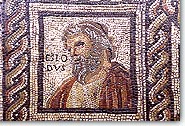

 | |
|
|
The dating of the poetic work of Hesiod is not clear, but is always related to a historical event. We know that the poet won the song contest at the funeral games of the hero Amphidamas, who was killed at a naval battle during the Lelantine war. The war between Chalkis and Eretria must have taken place at the end of the 8th century or at the beginning of the |  |
From Hesiod's works three survive intact and others in fragments, as referred to by the ancient writers. All of them are written in dactylic hexameter and are characterized by the conventions of the language and techniques of epic poetry. The oldest one is obviously Theogony, where the poet narrates the creation of the world, the succession of deities and the relations among them. Three hundred deities with their genealogical tree are included. All of them come from the original deities: the Night, the Sea and the union of the Earth with the Sky (Uranus). However, no deterministic interpretation is mentioned about the creation of the world. The most important union was that of the Earth and the Sky, which through the Titans and Cronus resulted in Zeus. Throughout the whole poem the intention to explain the world and natural phenomena is obvious. The Olympians always appear with anthropomorphic characteristics, which -according to many references- are attributed to earlier deities. The religious perceptions of Hesiod are a bit vague concerning the forces that rule the world, this continuing up to the Classical period. Thus to the Olympians Mother earth, the river gods and the nymphs of the springs and the forrests played a decisive role. |
The second work of Hesiod, Works and Days, is a hymn to the authority and justice of Zeus. Through some myths the poet often gives moral advice and precepts to his brother Perses. This is the first text of Greek literature with clear references to a moral class. The concepts that interest the poet are Hope, Justice and its opposite, Hubris. Through the descriptions of everyday life in a small Boeotian village, Hesiod gives us invaluable information about agriculture and the life of peasants during his time. The myth about the "iron age" of mankind is especially interesting, and does not seem to be related to the east, except perhaps as a distant relation of Egyptian theology. Finally, in Works and Days the rich imagination and the developed individual conscience of the poet are revealed through the energy and vitality of his verses, from the serious or ironic -but always original tone- as well as from the absence of sentimentality that distinguishes his style from that of Homer. |
The third work, which from time to time has been attributed to Hesiod, is The shield of Heracles. However, it is a fake work, most probably created during the |
|
| |
|
Note: Click on picture for short description. | |